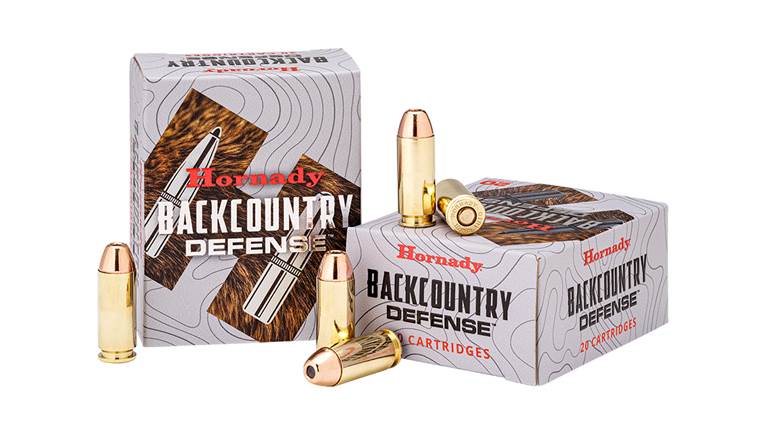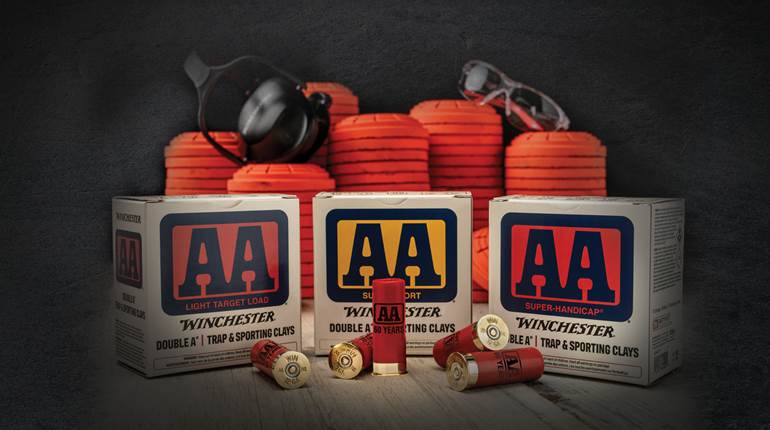
Fixed sights on handguns can be an annoyance escalating to aggravation when the sights point one place, but bullets hit another. Most handguns have a rear sight that can be drifted, so there is no problem aligning shots horizontally. Bringing bullets into line vertically, so they hit on aim at 25 yards, is the challenge. With some manipulation of bullet weight and velocity, though, handguns with fixed sights can hit where they aim.
Ron Reiber, the ballistician for Hodgdon Powder Company, said he has found moving bullet impact up or down is all trial and error. "There is no set way to tell that a bullet will move that much or in that direction," he said.
"Generally, the slower a bullet’s velocity, the longer it stays in the barrel, the more muzzle flip there is and the higher the bullet hits,” he said. “Speed up the bullet and it exits the barrel quicker and hits lower.” A relatively heavy bullet may also generate more recoil causing more muzzle flip unless the stiff recoil causes the shooter to grip the gun tightly, and retard some of the muzzle lift.
A handy combination for the .45 Auto is handloaded Speer Match TMJ SWC 185-gr. bullets
hitting the same place at 25 yards as inexpensive 200-gr. cast bullets.

Hornady FP XTP 125-gr. bullets, fired at 1,227 f.p.s. from the .357 Mag., hit an inch above aim at 25 yards.
Hornady FP XTP 125-gr. bullets, fired at 711 f.p.s. from the .38 Spl., hit 1.5”s above aim at 25 yards.
SIG Sauer Elite Performance .357 Mag. 125-gr. V-Crown JHP bullets hit pretty much on aim at 25 yards.

The .357 Mag. shooting Sierra JHC 158-gr. bullets, fired from a .357 magnum at 996 f.p.s hit 2.5”s above aim at 25 yards.
Propellants and Velocity
Handloaded cartridges with minimum to maximum amounts of propellant can move bullet impact up and down. For .45 Auto handloads, Reiber suggested loading a relatively slow-burning propellant, like Winchester 572, that produces the fastest velocity with a 230-gr. bullet. “From there you can start with a minimum load and increase charge weight to move bullet impact and get it shooting spot on,” he said. A rather narrow window of velocity exists where autoloading pistols will cycle on the low end of velocity to maximum velocity. Shooting a SIG Sauer 9 mm Luger, Speer 147-gr. bullets had an upward shift of 3”s at a velocity of 768 f.p.s., compared to the same bullet with a muzzle velocity of 969 f.p.s.
Revolvers, though, cycle all loads. Bullet velocities for the .357 Mag. can vary up to 400 f.p.s. However, with a velocity difference of nearly 200 f.p.s., Hornady 125-gr. bullets had only one inch of vertical spread at 25 yards The .38 Spl. shooting Lyman 155-gr. cast bullets, though, had longer vertical spread of 3.5”s with a velocity difference of only 93 f.p.s. That result goes back to Reiber’s caution that moving bullet impact up or down is all trial and error.
Cast 200-gr. bullets from an LBT mold hit right on aim when fired at 1,079 f.p.s. from a .357 Mag.
These bullets were fired in the .38 Spl. to determine how much velocity and bullet weight moved vertical impact at 25 yards. From left: Hornady HP 110-gr.; SIG Sauer Elite Performance FMJ 125-gr.; Hornady FP XTP 125-gr.; and 155-gr. bullets cast from a Lyman mold.
Varying Bullet Weight
Shooting different bullet weights definitely moved vertical impact. Speer 147-gr. bullets fired from the SIG 9 mm at 969 f.p.s. hit 3”s higher than 125-gr. bullets fired at similar velocities. Sierra 158-gr. bullets fired at 1,140 f.p.s., from the .357 Mag., hit 4” higher at 25 yards than 125-gr. bullets. I’ll speculate some of that higher impact can be attributed to increased muzzle climb from the stout recoil of the heavy bullet handloads.
These bullets loaded in the .357 Mag. were used to determine how much velocity and bullet weight moved vertical impact at 25 yards. From left: SIG Sauer Elite Performance 125-gr. V-Crown JHP; Hornady FP XTP 125-gr.; Sierra JHC 158-gr. and 200-gr. bullets cast from an LBT mold.
These bullets were shot in a Colt .45 Auto to determine how much velocity and bullet weight moved vertical impact at 25 yards. From left: Speer Match TMJ SWC 185-gr.; SIG Sauer Elite Performance JHP 200-gr.; Speer Gold Dot HP 200-gr.; Lee cast 200-gr. and N.O.E. cast 225-gr.
A couple of different loads that mesh with a handgun’s sights are convenient, even for guns with adjustable sights. I can practice and plink away a pleasant afternoon with my .357 Mag. shooting 125-gr. bullets, either SIG Sauer’s factory cartridges or handloaded Hornady bullets paired with Power Pistol propellant. When hunting season arrives, I can change to 200-gr. flat nose cast bullets, cast from an LBT mold, which hit the same place at 25 yards as the practice and plinking loads. That switch doesn’t require remembering how many clicks up or down of an adjustable sight are necessary to bring the sights to bear between loads.
These bullets were shot in a SIG 9 mm to determine how much velocity and bullet weight moved vertical impact at 25 yards. From left: SIG Sauer FMJ 115-gr.; Speer TMJ RN 115-gr.; MP cast 125.8 gr.; and Speer TMJ RN 147 gr.
Last week I was practicing with my Smith & Wesson 329PD .44 Mag. shooting 240-gr. cast bullets at a leisurely 770 f.p.s. Recoil was like a pat on the back. This week elk season opened. To watch my back in grizzly country, I changed the .44’s load to Sierra 240-gr. JHC bullets, which with a muzzle velocity of 1,190 f.p.s. hit the same place at 25 yards as the practice loads. Some trial and error was required to make those loads mesh. The toil was well worth it, though, to ensure the different loads shoot the same place as the revolver’s sights pointed.
SIG Sauer Elite Performance FMJ 115-gr. bullets hit right where the fixed sights of a SIG Sauer SP2022 9 mm aimed at 25 yards.








































